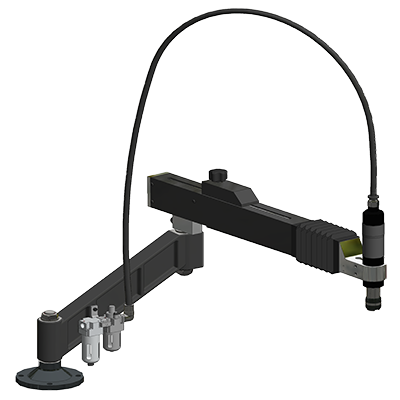- FlexCNC
- C-Series FlexCNC
- G-Series FlexCNC
- FlexCare+
- FlexBEAM CNC Structural Machining
- FlexBeam CNC
- FlexJet Waterjet Solution
- FL-Series
- F-Series
- FLX-Series
- FlexArm
- Tapping Arms
- Tables, Accs. & Tap Holders
- Taps & Accessories Store
- Die Grinding Arms
- Drilling Arms
FlexErgo
- Torque Reaction Arms
- Balance Arms
- Part Manipulator Arms
For service please call
937-210-9541 or
Request Service Here
Choosing the Right Tapping Arm: A Guide to Pneumatic, Electric, and Hydraulic Arms
When it comes to choosing the right tapping arm, the decision depends on several factors, including the specific application requirements, production volume, and budget. Here are some key considerations to help you choose the right tapping arm for your needs.
Pneumatic tapping arms are powered by compressed air and are the most affordable option. They are best suited for smaller hole tapping ranging from 00 to 7/8″ but have enough power to handle tougher materials such as stainless steel and titanium. They are also ideal for applications where portability and ease of use are a priority. One downside to pneumatic tapping arms is that a clean, consistent air source is required. If you do not have clean shop air, an electric arm may be a better option.
Electric tapping arms are powered by an electric power pack plugged into your standard 110V outlet. These arms offer faster tapping speeds and a quieter operating noise than pneumatic tappers. The electric models can handle taps from 00 to 7/8″ and provide a maximum reach of up to 70″. Electric tapping arms are best suited for those wanting a fast, reliable tapping machine with minimal maintenance.
Hydraulic tapping arms are powered by hydraulic power packs, which require a 480V outlet. It provides the highest torque levels (up to 811 ft/lbs of torque, making it suitable for large and heavy-duty tapping operations. The hydraulic models can tap up to 2″, but due to the torque output, they are not the best at handling smaller tap sizes. We recommend nothing smaller than 1/4″. The downside to the hydraulic tapping arm is that it requires a heavy hydraulic power pack and is more expensive than its counterparts.
In conclusion, the type of tapping system you choose will depend on your specific needs and budget. Choose a pneumatic tapping arm if you want a lightweight, portable option for light-duty tapping. An electric tapping arm might be your best bet if speed and fewer maintenance requirements are important. For heavy-duty tapping, a hydraulic tapping arm is the right choice. If you are still trying to decide which tapping arm is best for you, contact us, or give us a call at 1-800-837-2503. Our FlexArm experts would be happy to help select the best option for you.
Related Topics
Five Dynamic Uses for the FlexCNC
The FlexCNC is a highly automated functional machine that employs a vertical spindle and worktable orientation, allowing operations on a horizontal machining bed. The FlexCNC can perform various functions for numerous specialized projects, saving you space and money with...
Read MoreFlex Machine Tools Launches the new Flexible Tapping Center
Flex Machine Tools is excited to launch a new product that will revolutionize your workshop: the Flexible Tapping Center (FTC). This specialized machine is equipped with superior precision, innovation, and performance to produce quality products for your business. Typically,...
Read More
Take the Risk Out of Choosing Tapping Arms:
Free Tap Test by FlexArm
When selecting machinery for your company, deciding what tools will work best for your product can be overwhelming, and it can feel like a risk when you need to know if the product you bought will be the right...
Read More


